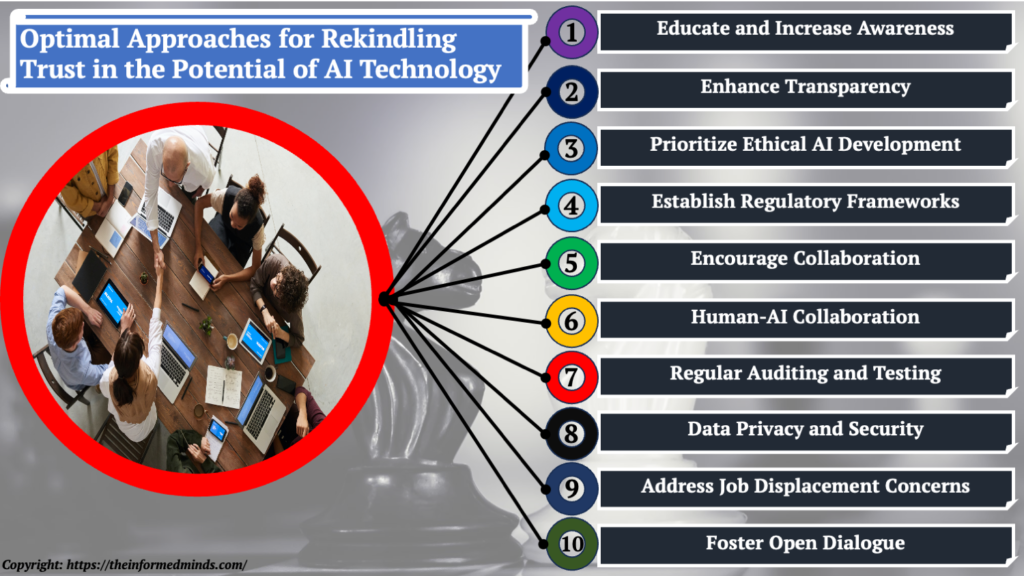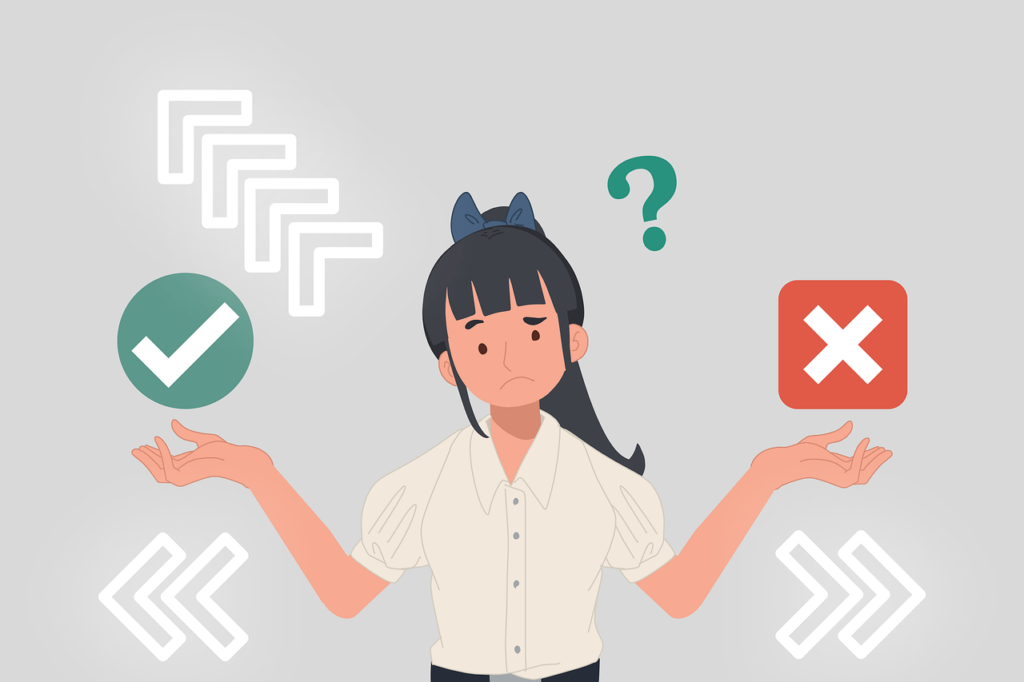To Share is to Show You Care!
In the rapidly evolving landscape of technology, artificial intelligence (AI) has emerged as a powerful tool with immense potential. However, the journey of AI adoption has been marred by concerns about ethics, bias, and transparency. Rebuilding trust in AI is crucial to unlocking its full potential and ensuring a harmonious integration into our lives. In this blog post, we’ll delve into the best strategies for restoring faith in technology’s promise.
Here are the top 10 reasons why people might not be trusting AI at present,
- Lack of Understanding: Many individuals don’t fully comprehend how AI works and make decisions, leading to mistrust due to perceived complexity and mystery.
- Bias and Discrimination: Concerns about biased AI algorithms that perpetuate social biases, leading to unfair outcomes in areas such as hiring, lending, and law enforcement.
- Opaque Decision-making: When AI systems make decisions without providing transparent explanations, users feel uncertain and are hesitant to trust outcomes they can’t comprehend.
- Privacy Concerns: Worries about the collection and use of personal data by AI systems, especially in instances where users feel their privacy is compromised.
- Fear of Job Loss: The fear that AI automation might replace human jobs, causing economic instability and furthering the distrust of technology’s impact on livelihoods.
- Ethical Dilemmas: AI’s involvement in making critical decisions, such as in healthcare or autonomous vehicles, raises ethical questions that contribute to skepticism.
- Lack of Accountability: Perceptions that AI technologies lack accountability for mistakes or wrong decisions, making users hesitant to fully rely on them.
- Rapid Technological Changes: The swift evolution of AI leads to concerns about unexpected consequences and uncertainties, eroding trust in the technology’s stability.
- Media Portrayals: Negative portrayals of AI in media, including dystopian scenarios where AI goes rogue, contribute to the public’s distrust of AI’s intentions.
- Limited Human Oversight: Worries that AI systems operate with minimal human oversight, reducing the ability to intervene or correct errors when necessary.
These reasons collectively contribute to the current lack of trust in AI. Addressing these concerns through transparency, ethical development, education, and responsible AI deployment can help rebuild trust in this transformative technology.
Best strategies for restoring faith in technology’s promise

1) Educate and Increase Awareness

One of the foundational steps to rebuilding trust in AI is to educate the public and increase awareness about what AI is and what it can do. Host workshops, webinars, and educational campaigns to explain AI concepts in simple terms. Address common misconceptions and provide real-world examples of AI applications that have benefited society. By fostering understanding, you can alleviate fears and uncertainties surrounding AI technology.
2) Enhance Transparency
Transparency is key to building trust in AI systems. When AI makes decisions, users should be able to understand how those decisions were reached. Implement algorithms that provide explanations for their outcomes in human-readable language. This could involve techniques like generating “explanation reports” that detail the factors considered by the AI. The more users can comprehend the reasoning behind AI actions, the more they’ll trust its decisions.

3) Prioritize Ethical AI Development

Bias and discrimination are critical concerns in AI development. To restore trust, prioritize ethical considerations throughout the AI lifecycle. Ensure that training data is diverse and representative to avoid perpetuating biases. Regularly audit algorithms for unintended biases and take corrective measures. Incorporate ethics committees into the development process to assess potential ethical implications.
4) Establish Regulatory Frameworks
Governments and organizations must collaborate to create clear regulations that govern AI development and use. These regulations should cover areas such as data privacy, algorithmic transparency, accountability, and safety. By setting clear guidelines and standards, stakeholders can be assured that AI technologies are being used responsibly and ethically.

5) Encourage Collaboration

Rebuilding trust requires a collective effort from various disciplines. Collaborate with experts in technology, ethics, law, sociology, and more to address multifaceted challenges. Establish cross-functional teams that can develop comprehensive solutions that consider both technical and ethical aspects of AI deployment.
6) Human-AI Collaboration
Promote the narrative that AI is a tool that enhances human capabilities rather than a replacement. Highlight successful examples of humans working alongside AI to achieve better outcomes. Showcase instances where AI has improved efficiency, accuracy, and creativity in industries such as healthcare, finance, and art.

7) Regular Auditing and Testing

Bias and errors can creep into AI systems over time. Regularly audit and test AI algorithms to identify and rectify these issues. Implement safeguards that alert developers when unintended biases are detected. Ongoing testing ensures that AI remains unbiased and reliable in its decision-making.
8) Data Privacy and Security
Address concerns about data privacy and security head-on. Clearly communicate to users how their data is collected, used, and protected. Implement strong encryption and cybersecurity measures to safeguard user data from breaches. Providing transparent data handling practices will enhance user confidence in AI systems.

9) Address Job Displacement Concerns

To rebuild trust, address worries about AI replacing human jobs. Initiate programs that offer reskilling and upskilling opportunities for individuals whose professions might be impacted by AI automation. By providing pathways to adapt and thrive in the changing job landscape, you can alleviate fears of economic instability.
10) Foster Open Dialogue
Create platforms for open and honest discussions about AI. Engage developers, policymakers, users, and the general public in conversations about AI’s potential benefits and risks. Encourage feedback, incorporate diverse perspectives, and involve the public in shaping AI policies and regulations.

Conclusion
Rebuilding trust in AI requires a comprehensive approach that encompasses education, transparency, ethics, collaboration, and accountability. By implementing these strategies, we can pave the way for a future where AI is embraced with confidence, and its potential is harnessed for the betterment of society. It’s time to work together to restore faith in technology’s promise and create a more inclusive AI-powered world.
Frequently Asked Questions
Q1: How do you teach AI the value of trust?
A: Teaching AI the value of trust involves training it with data that emphasizes transparency, fairness, and ethical decision-making. AI models can be fine-tuned to prioritize explanations for their decisions, reduce bias, and align with ethical guidelines.
Q2: Why is there a lack of trust in AI?
A: The lack of trust in AI stems from factors like biased outcomes, opaque decision-making, concerns about data privacy, job displacement fears, and rapid technological changes. These issues contribute to uncertainty and skepticism about AI’s reliability and intentions.
Q3: How to thrive in this new era of AI with trust and confidence?
A: To thrive in the AI era with trust and confidence, individuals and organizations should prioritize transparent AI algorithms, ethical development, provide explanations for AI decisions, offer training for those affected by job displacement, and actively engage in discussions about AI’s impact.
Q4: How do you get people to trust AI predictions?
A: Building trust in AI predictions involves providing understandable explanations for the predictions, demonstrating the accuracy and fairness of the models, and involving users in the decision-making process to foster a sense of control and accountability.
Q5: What are the 7 principles of trustworthy AI?
A: The 7 principles of trustworthy AI are fairness, transparency, accountability, reliability, privacy, robustness, and inclusivity. Adhering to these principles ensures that AI systems are developed and deployed in an ethical and trustworthy manner.
Q6: What are the 7 pillars of trustworthy AI?
A: The 7 pillars of trustworthy AI, as outlined by the IEEE, are transparency, accountability, awareness of limits, addressing bias, ensuring human values, control over AI, and ensuring long-term safety. These pillars guide the development of responsible AI systems.
Q7: How does work to build trust in artificial intelligence?
A: Building trust in artificial intelligence involves addressing biases, providing clear explanations for AI decisions, ensuring privacy and security of user data, fostering collaboration between stakeholders, and adhering to ethical guidelines throughout development and deployment.
Q8: Why do people mistrust AI?
A: People mistrust AI due to concerns about bias, opaque decision-making, potential job loss, ethical dilemmas, lack of accountability, and fears of rapid technological change. These factors contribute to skepticism about AI’s intentions and reliability.
Q9: Do intelligent people have trust issues?
A: Trust issues can affect individuals of varying intelligence levels and are not solely tied to intelligence. Factors such as past experiences, personality traits, and external influences play a role in determining trust levels.
Q10: What are IBM’s 5 pillars of trust?
A: IBM’s 5 pillars of trust for AI are fairness, explainability, robustness, accountability, and ethics. These pillars guide the development and deployment of AI systems that are responsible and trustworthy.
Q11: What kind of trust does AI deserve if any?
A: AI deserves a trust built on transparency, accountability, and demonstrated reliability. Users should trust AI systems that provide clear explanations, exhibit fairness, and align with ethical standards.
Q12: What is the biggest fear of implementing AI?
A: The biggest fear of implementing AI is often the fear of job displacement. People worry that automation and AI technologies might replace human jobs, leading to economic instability and loss of livelihoods.
Q13: What percentage of people trust AI?
A: The level of trust in AI varies among individuals and contexts. Surveys suggest that trust in AI is still relatively low, with many people expressing concerns about bias, privacy, and ethical implications.
Q14: How many people don’t trust AI?
A: A significant percentage of people express varying degrees of distrust in AI due to concerns about bias, transparency, and potential negative impacts on society and jobs.
Q15: How do you calibrate trust?
A: Calibrating trust involves assessing the performance and behavior of AI systems over time, comparing predictions to outcomes, and adjusting user expectations based on the system’s track record. Transparent explanations for AI decisions also contribute to calibrated trust.
The Informed Minds
I'm Vijay Kumar, a consultant with 20+ years of experience specializing in Home, Lifestyle, and Technology. From DIY and Home Improvement to Interior Design and Personal Finance, I've worked with diverse clients, offering tailored solutions to their needs. Through this blog, I share my expertise, providing valuable insights and practical advice for free. Together, let's make our homes better and embrace the latest in lifestyle and technology for a brighter future.

